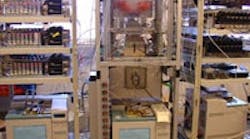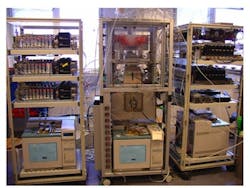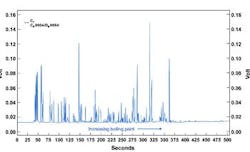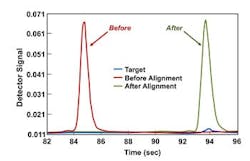The application of combinatorial or high-throughput methods to the discovery and commercialization of new heterogeneous catalysts requires a means of rapidly screening the performance of novel materials. To meet this requirement, UOP Honeywell and SINTEF have a long history of collaborating, developing and optimizing new and efficient tools capable of measuring key catalyst-performance variables. A critical enabler of combinatorial screening is high-speed analysis. However, in parallel testing units, complex analyses often demand a significant amount of time to manually reprocess files. In some cases, this could incur a reduction in testing rate. Furthermore, post-run reprocessing efforts frequently are complicated, tedious, time-consuming and prone to human error. In this article, we will illustrate an effective real-time automated solution to correcting retention time shifts across multiple gas chromatographs with multiple detectors that might lead to peak misidentifications. The solution directly integrates multivariate correlation-based chromatographic alignment software into the high-throughput test control software.
THE CATALYST DISCOVERY PROCESS
The search for a suitable prototype catalyst may require many experiments to screen different chemical elements, additives, substrates and treatments. In addition, evaluation of catalyst substances must take place at relevant temperatures and pressures using applicable chemical feedstocks. This often necessitates a very large number of tests. High-throughput testing and combinatorial approaches have emerged not only as a contributor to catalytic science but as an enabler to product commercialization. The sequential strategy requires a workflow process incorporating catalyst library design and construction, primary or secondary screening, and piloting. Figure 1 shows one of our high-throughput systems for catalyst screening.
Figure 1. This unit, developed by UOP and Sintef, includes 48 reactors to test 48 samples.
High-throughput capabilities and infrastructure for catalyst discovery at UOP Honeywell utilize an integrated end-to-end methodology. It encompasses: a combinatorial synthesis of material libraries; catalyst preparation using ion exchange and impregnation; catalyst finishing such as oxidation, steaming and chlorination; catalyst pretreatments done either in-situ or ex-situ; and parallel testing of catalytic formulations to rapidly identify prototypes for commercialization. Specific program objectives have led to the development and application of innovative tools, novel experimental methodologies, predictive performance models, and optimization tools for heterogeneous catalyst discovery. The tools and methodologies routinely are used in catalyst discovery and technology development projects with broad economic and societal returns.
The current infrastructure supports a wide range of UOP Honeywell process-development, catalyst-development and commercial-support projects. By applying unique testing methodologies, the coverage of process technologies with assorted feedstocks and reactor phase regimes is extensive. Furthermore, the infrastructure is flexible to allow exploration of future process technologies.
The growth in the processing of high-molecular feedstocks with more-complex product distributions (Figure 2) presents challenges for high-speed analytical methods, making innovations necessary. For example, this paper discusses the development of automated chromatographic alignment tools to ensure proper peak identifications with minimal human intervention.
CHALLENGES
The defining feature of a high-throughput system is the quantity of analyses per unit time. In this case, the analysis is defined as a gas chromatograph (GC) injection. As those skilled in the art of high-throughput testing well understand, conducting a statistically meaningful experiment requires multiple injections. These are achieved by a combination of a process flow scheme that directs multiple reactors to an instrument and the use of several analytical instruments per test system. The length of the analytical method, product complexity, the requested test length, and the anticipated testing demand determine the numbers of reactors multiplexed onto a given analytical instrument and the total number of instruments per system.
Figure 2. High-throughput testing of high-molecular feedstocks often generates complex chromatograms.
Figure 3. Method yields a revised result whose retention time matches the target.
Figure 4.Software-aligned results exhibit significantly lower variability than the original results.
MARK KRAWCZYK is a principal R&D engineer at UOP LLC, a Honeywell company, Des Plaines, Ill. CHARLES P. MCGONEGAL and MATTHEW J. SCHMIDT are senior R&D scientists at UOP in Des Plaines. MIKE MCCALL is principal R&D scientist and J. W. ADRIAAN SACHTLER is senior principal R&D scientist at UOP in Des Plaines. MARTIN PLASSEN is research scientist, ARNE KARLSSON is chief scientist and ELISABETH M. MYHRVOLD is senior engineer at SINTEF Materials and Chemistry, Oslo, Norway. E-mail them at [email protected], [email protected], [email protected], [email protected], [email protected],
[email protected], [email protected] and [email protected].
LITERATURE CITED
1. Nielsen, N-P. V., Carstensen, J. M.and Smedsgaard,J., “Aligning of Single and Multiple Wavelength Chromatographic Profiles for Chemometric Data Analysis Using Correlation Optimised Warping,”J. Chromatogr. A, Vol. 805, pp.17–35 (1998).
2. “LineUp User Guide,”V. 3.5.0, Infometrix, Bothell, Wash. (September 2012).






